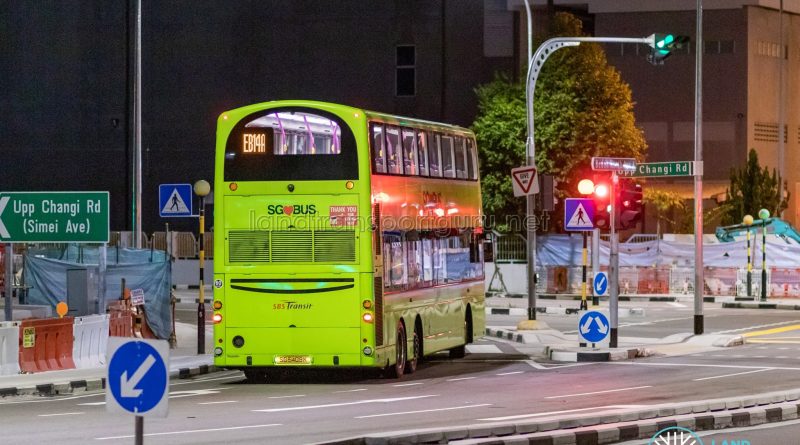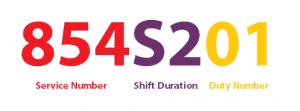Bus and Driver Scheduling are an integral part of bus operations. Bus operators in Singapore rely on the adherence of schedules to meet service standards laid out by the Public Transport Council and to maximize the efficiency of bus services.
Introduction
Public Transport Operators (PTOs) are faced with many challenges in the area of bus operations, such as meeting service requirements for various bus routes, and the pressure to maximize the use of their resources (be it bus drivers or vehicles). In urban cities with large-scale bus operations such as Singapore, bus planning is of great importance, since large amounts of money can be saved if the available resources are employed efficiently, or wasted if not.
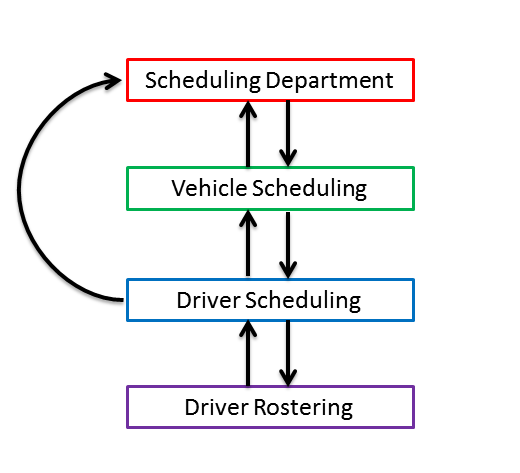
Bus and driver scheduling are important in the day-to-day management of resources. A simplified diagram is shown on the right to illustrate what goes on within bus operations. A dedicated scheduling department is responsible for the complex job of managing the overall movement of buses on a day-to-day basis, by ensuring that buses need to be where they should be, since buses can ply multiple bus routes in a day. This translates to vehicle scheduling, where buses are assigned to various bus routes, and every single bus has a fixed timesheet to follow throughout the day. Because buses can be taken out of revenue service for various reasons (such as breakdown or scheduled maintenance works), every revenue service bus starts its day by being allocated to a shift, which will be fully explained later.
After vehicle scheduling is done, driver scheduling is needed to generate daily duties for bus drivers. Drivers are allocated to various working shifts, during which they will be in charge of the operations of their respective buses in adherence to the published timesheet. Finally, driver rostering constructs duty rosters for individual bus drivers, including overtime work, rest days, and holidays. These four aspects of bus and driver scheduling are closely interlinked and key to the daily operations of bus services. However, emergency situations allow for impromptu changes in vehicle and driver scheduling, which will be discussed later on.
A – Vehicle / Driver Scheduling:
Bus operations rely on vehicle scheduling to assign buses to various bus services on a daily basis. This is done by arranging bus deployments in shifts, where every shift will be allocated to a driver. The shift dictates the scheduled movement of a particular bus for a duration of time, and every shift is given a reference code that differs between bus operators.
Commonly used shift durations are summarized below. Note that SBST uses single-letter notations but SMRT uses double-letter notations; newer incumbents (Tower Transit and Go Ahead) use some version of the following designations:
| SBST | SMRT | Shift | Approximate Duty Hours |
| A | AM | Morning shift | 5-6 am till 2-4 pm |
| P | PM | Afternoon shift | 2-4 pm till 12-2 am |
| S | S1 | Split shift | 5-7 am till 8-9 am, Split Break, then 3-4 pm till 6-7 pm |
| E | S2 | Extended split shift | 5-7 am till 9-10 am, Split Break, 12-1 pm till 6-7 pm |
| T | TQ | Three-quarter shift | 6-7 am till 6-7 pm |
AM/PM Shift
A and P shifts are the most commonly-used shifts. The A or AM shift takes care of morning shift operations, while the P or PM shift continues off from the AM shift, and ends after revenue services end for the day. The AP shift is a shorthand designation for a bus that operates for a full day of revenue service (hence covering the working hours of two bus drivers). Drivers are split into AM shift and PM shift, as explained above.
Both A and P shifts have designated meal break times; lunch for A shift and dinner for P shift. These are paid meal break hours that count towards the duration of the shift.
Split Shift
S shift, or split shift, is where a regular seven to eight-hour shift is split into two parts: morning and evening. This form of split-working-day arrangement is common during weekdays to accommodate additional drivers during the rush hour when more buses are deployed. Drivers are on the job during the peak periods only and receive an unpaid break time (called Split Break (SMRT) & Swing Break (SBST)) in between shifts. Some of these duties extend into the late morning hours to cover the lunch break period of A shift drivers.
During the lengthy split shift breaks, drivers may choose to return home or rest at the bus depot, with newer bus depots featuring more rest and recreational facilities to benefit split shift drivers. Despite the odd working hours, split shifts provide more opportunities for overtime pay, with some shifts ending as late as 9 pm or later.
An extended version of the split shift, termed E shift by SBS Transit and S2 by SMRT, starts the second part of their shift in the early afternoon rather than in the late afternoon. This arrangement is often used by bus services serving education institutions (though not exclusively) and matches the commuting patterns of school students. Thus, in addition to the normal peak hours, this form of extended split shift is used to increase the availability of buses in the early afternoon periods. SMRT has traditionally made more extensive use of the S2 shift than SBS Transit’s T shifts.
TQ Shift
T shift (SBST), also known as TQ shift (SMRT), refers to a three-quarter shift, starting at around 6-7 am and ending at 6-7 pm. T shift is often used on weekends when bus services experience stable demand for the day but substantially less demand at night, hence the T shift fits well with regular commuting patterns. Also, day-operating services such as Service 115 use the T shift on a daily basis. All T shifts include a meal break (lunch), but only the longer-duration ones come with a coffee break in the afternoon.
It is worth mentioning that meal breaks that we discuss are referring to paid meal breaks, i.e. lunch or dinner breaks incorporated into part of the driver’s working schedule and hence included in his or her paid working hours.

Night Shift
Night shift drivers are typically deployed on Employee Bus Services that ferry Bus Captains to and from the bus depot during the early morning hours (12 am to 5 am).
Prior to the withdrawal of night bus services, night shift drivers were also deployed to NightRider services and Nite Owl services. Their duties often included additional late-night trips before 12 am, serving various high-demand trunk services, particularly in the City area.
SBS Transit:
SBST uses the A/P/S/E/T notation to denote shifts. Shifts are organised as: (Reference Number) (Shift Duration), without the inclusion of the bus service number. Reference numbers are used in the A/P/S/E/T order, starting from one, until the last shift.
For illustration purposes, let’s consider SBS Transit Service 4, with six buses in it’s fleet (as of 2013).
The weekday deployment is as follows: 4AM–4PM / 1S / 1T .
Hence, the weekday shifts are: 1A, 2A, 3A, 4A, 5P, 6P, 7P, 8P, 9S, 10T
Notice that the numerical order adheres to the APSET notation. 1A and 4P use the same bus, same for 2A & 6P, 3A & 7P, and 4A & 8P. Collectively, 1A to 8P can be referred to as 4 A/P, which means that 4 buses operate on Service 4 for the entire day. Subsequently, 9S and 10T refer to one S-shift and one T-shift bus respectively. Hence, service 4 has 10 shifts every day.
Let’s use another example, SBS Transit Service 156
The weekday deployment is as follows: Hougang 7AM–8PM / 7S; Bt Batok 4AM-4PM / 1S / 1E
Because service 156 is dual-depot controlled, the APSET notation will be continued in numerical order after completing all the shifts of the first depot.
Hence from Hougang Depot, the weekday shifts are:
1A, 2A, 3A, 4A, 5A, 6A, 7A, 8P, 9P, 10P, 11P, 12P, 13P, 14P, 15P, 16S, 17S, 18S, 19S, 20S, 21S, 22S
Continuing on, Bukit Batok Depot shifts are:
23A, 24A, 25A, 26A, 27P, 28P, 39P, 30P, 31E, 32S
Collectively, Service 156 has 7 – 8 A/P buses from HGDEP and 4 A/P buses from BBDEP. Including E and S shifts, this service has a total of 32 shifts in a day, corresponding to a total of 32 drivers deployed on this route on weekdays.
There are exceptions to the numerical order used in this notation. Duty numbers between 80 and 90 correspond to drivers who are allocated to drive at least two different buses during the course of their shift rather than sticking to one bus for the whole day’s shift, a practice known as “jump bus”. For deployment nomenclature, visit the Bus Deployments Overview article.
SMRT Buses:
SMRT uses a slightly different method of denoting shifts, using AM, PM, S1, S2, and TQ to denote shift duration. Shifts are organised as: (Service Number)(Shift Duration)(Duty Number). Reference numbers are two-digit numbers than run in numerical order, with exceptions (later explained). For AM and PM shifts, similar duty numbers usually denote the same vehicles, e.g. 189AM01 and 189PM01 use the same bus (but different drivers on the AM and PM shift respectively). Combined, they are referred to as 189AP01.
Although SBS Transit uses the letter S to designate S shift, SMRT employs a more complicated designation involving S1 and S2. There are distinct differences between these two shifts, the main one being that S1 has more trips for the AM portion, while S2 has more trips for the PM portion.
S1 shift working hours are usually between 6am to 11am/12pm, followed by 4pm to 7pm/8pm. They almost always never come with a paid meal break (some rare exceptions have a lunch break included, such as Service 171 which ends its morning portion at 1 pm). The S1 shift is usually heavier in the morning portion and less in the evening.
In contrast, S2 working hours are usually between 6am to 9am/10am, followed by 1pm to 7pm/8pm. They always come with a scheduled lunch break (lunchtime varies between shifts) and an afternoon coffee break. The S2 shift is usually less heavy on the morning portion but heavier on the evening portion. It is also the longest duration shifts in SMRT bus planning, commonly exceeding 9 hours. Before SMRT actively cut down on driver operating hours, its split shifts routinely exceeded 10 hours, and the longest ones exceeded 11 hours.
Another quirk in SMRT shifts is the use of the number 5 in the first digit of the duty number to denote a crossover slot. For example, duty 911S150 is used for an Intratown 911 bus that does crossover trips to Feeder 901 during Weekdays AM Peak. Although the crossover service is not reflected in the duty number, S150 is an indication of a crossover bus (since S1 is the shift and 50 is the duty number). The use of ‘5’ in the first digit always refers to a crossover slot, but not exclusively, due to the large number of crossover trips involved in SMRT bus planning.
As an example, we use SMRT Service 169.
The weekday deployment is as follows: 11AM–11PM / 9 S1 / 3 S2 (as of 2013)
Hence, the shifts are as follows:
- AM: 169AM01 169AM02 169AM03 … … 169AM11
- PM: 169PM01 169PM02 169PM03 … … 169PM11
- S1: 169S101 169S102 169S103 … … 169S108 + Additional 169S190
- S2: 169S201 169S202 169S203
Hence in total, Service 169 has a total of 34 shifts operating on a weekday. 169S190 is a BSEP slot: regardless of service, BSEP Buses in SMRT are assigned a duty number of 9x. In the above case, this case the duty number is 90, operating on the S1 timesheet.
It is worth noting that buses from other services perform crossover trips on Service 169. Because a shift denotation can only reflect its parent service, it is difficult to estimate the full number of buses on a route unless the crossovers are known. In the case of service 169, duties 857S150, 963S159 and 971ES201 perform crossovers to this service during weekdays. Also note how the 5x duties denote crossover slots (as mentioned previously).
Here are some case examples of duty numbers:
- 854AM14: Service 854 bus, #14 on the AM shift. Does one trip of Express 854E on weekday mornings.
- 971ES102: Service 971E bus, #02 on the S1 shift. Does crossover trips on Service 962 (not reflected in duty number).
- 167S154: Service 167 bus, #54 on the S1 shift. Does crossover trips on Express 854E followed by Premium 531 on weekday AM peak hours.
- 854S201: Service 854 bus, #01 on the S2 shift. Does one trip of Express 854E on weekday mornings.
- 945S201: One of the duties spanning the most number of bus services, namely 188, 530 and 941 during AM Peak and 945 during PM Peak. This shift has since been modified to exclude 941.
Peak hour bus routes are operated solely on S-shift buses. For example, SMRT Service 177 runs 4 S1 buses, with a duty code of 177S150, 177S151, 177S152 and 177S153. All four buses cross over to Service 925 (hence the 5x duty number).
Bus schedules are part of the internal operations of bus companies and are not available to the public, and all schedules available to bus enthusiasts are based on physical spottings of timesheets on various buses. By understanding how shifts work, one can easily appreciate the massive complexity that goes into planning daily bus operations. SMRT NightRider services had previously operated on a dedicated fleet using the PM timesheet designation (i.e. NR1PMxx), which has since been replaced by crossover buses from trunk services.
B: Timetables
Bus companies issue timetables for respective shifts. When a driver is in charge of a particular shift for the day, he or she will need to follow the timetable issued by the scheduling department. Hence. the timetable dictates bus movements throughout the duration of the shift.
SBS Transit and SMRT issue different forms of timetables to drivers, as we will explore below.
SBS Transit:
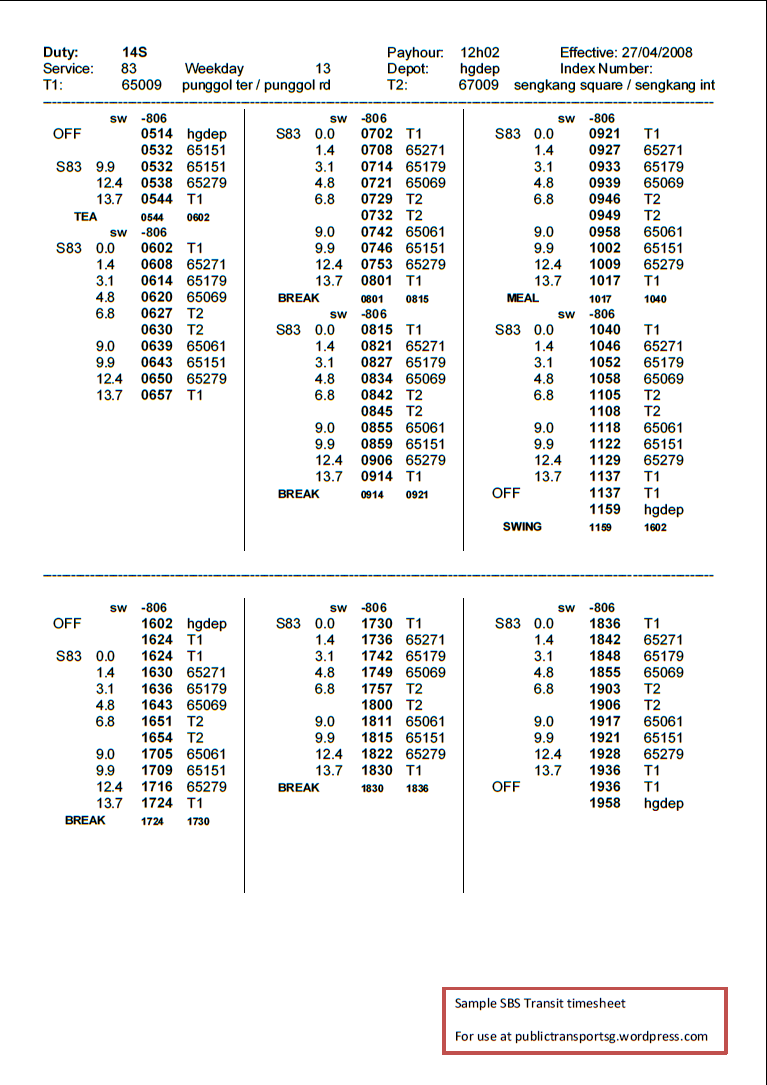
Here is a sample timesheet published by SBS Transit. At the top left-hand corner, it is introduced that this is the 14S timetable for Service 83, a loop service. All timings are indicated in bold so it’s easy to see what’s going on. Here, the page is divided into two parts, with the morning split shift timings at the top and the afternoon split shift timings at the bottom.
This particular shift starts at 5:14 am from Hougang Depot (HGDEP), and travels Off Service (i.e. deadheading) to bus stop 65151 (the 9.9km mark) where it performs a partial trip of Service 83 from that bus stop to Punggol, reaching the interchange at 5:44 am. After performing five more complete rounds of service 83, the bus returns to Hougang Depot at 11:59 am, concluding the morning shift. “SWING 1159 1602” implies that the driver takes a split break from 11:59 am and will resume driving duties at 4:02 pm.
For the afternoon shift, the bus departs the depot at 4:02 pm and reaches Punggol Interchange at 4:24 pm, thereby immediately starting a trip of Service 83, and returning back to T1 at 5:24 pm for a six-minute break, departing again at 5:30 pm. After its third trip of the PM shift, the driver leaves Punggol Int at 7:36 pm and returns to the depot at 7:58 pm, concluding the shift for the day.
A PDF copy of the timesheet is available at the bottom of the article.
SMRT Buses:
The timesheet layout used by SMRT Buses is slightly different from SBS Transit. The following timesheet is an old version and SMRT has since revised its timesheet layout.
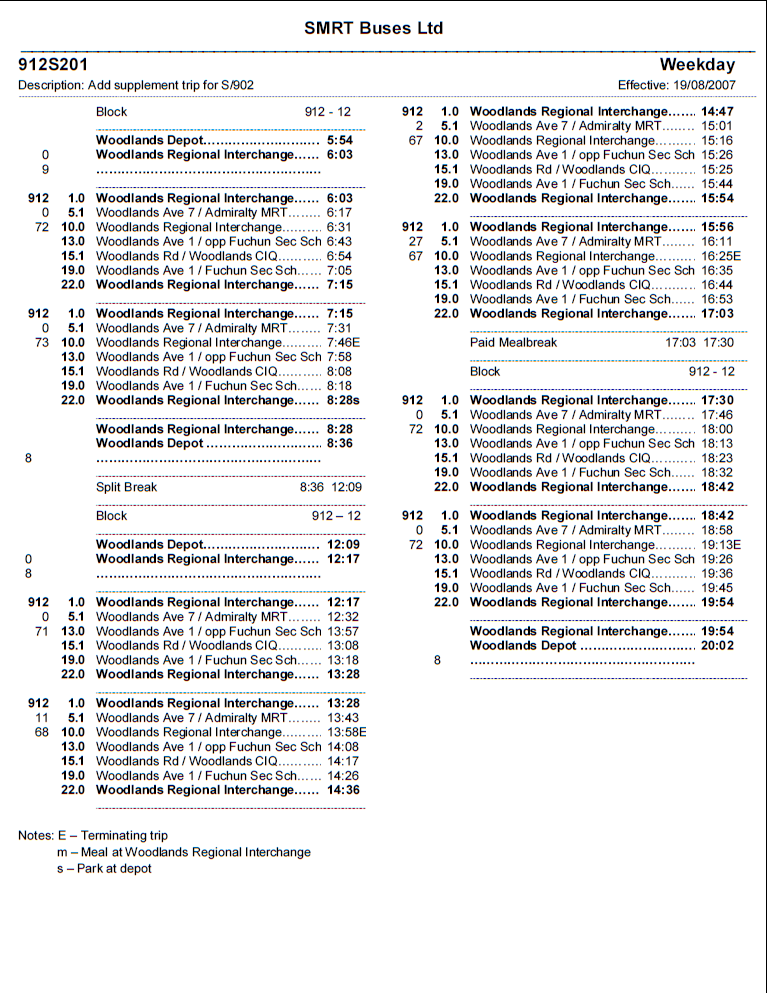
Here we have a sample timesheet from 912S201, an Intratown 912 bus running on the S2 split-shift on weekdays. The “Block” is used to divide the timetable and is of little importance. We will go through the timetable starting from the top left. If you have noticed, this is an S2 timetable, which is equivalent to an E shift in SBS Transit.
The first entry shows the bus at Woodlands Depot at 5:54 am, and at Woodlands Regional Interchange at 6:03 am. This is a non-revenue service trip (i.e. Off Service) to reposition the bus from the depot to the bus interchange. The 0 and 9 on the left column simply mean that the journey from the depot to the bus interchange is scheduled for 9 mins, and there is no layover time (i.e. 0 mins) after reaching the interchange.
Below, the second set of entries shows the bus doing two full rounds of Intratown 912. On the leftmost column, 912 stands for the service number, 0 refers to the layover time in minutes (upon completing the route), and 72 refers to the runtime in minutes. Notice that the bus starts the trip at 6:03 am, right when he reaches the interchange, hence the layover time is zero. The second left column indicates the various distances that correspond to the bus stops written in the center column. Since our timetable is dated in 2007, the numbers would be in fare stages, but all recent timetables have their distances written in kilometers. After two consecutive trips, the bus arrives at Woodlands Interchange at 8:28 am, where it will go out of service and return to the depot at 8:36 am. Notice how the shift does not incorporate any layovers at all, from leaving the depot until returning to the depot, a duration of 2.5hours. This is reflective of the rigor involved in driving Intratown routes during the peak hours, to cater to the large increase in demand during peak hours.
Upon arriving at the depot, the driver takes a split break until 12:09 pm, where he/she departs the depot and returns to Woodlands Interchange at 12:17 pm, immediately starting another round of 912 until 1:28 pm. After the completion of the 1328hrs departure of 912, he/she gets an 11-minute break. The rest of the timetable can be inferred from the above information.
Finally, note that there is a paid meal break from 17:03hrs to 17:30hrs. As explained under section A, all S2 shifts come with a meal break, while S1 rarely or never comes with a meal break.
A PDF copy of the timesheet is available at the bottom of the article.
C: Working Hours
Bus driver working hours are entirely dependent on the shift that they are allocated to. Depending on shifts, bus drivers report to either a bus depot or a bus interchange to start their shift. Most AM shift drivers would collect their buses from the depot at the start of their shift, while PM drivers would take over buses from their AM counterparts at the interchange, driving them back to the depot at the end of the day, and the cycle repeats.
Currently, both SBS Transit and SMRT Buses employ a six-day work week, with the basic working hours per week spread across six days. SMRT employs a 44-hour basic working week, and that for SBST is likely to be around the same. Drivers who exceed the basic working hours get paid an overtime rate of 1.5 times the usual pay. Overtime pay is capped at 72 hours per month, in line with Ministry of Manpower regulations. The basic pay for Singaporean bus drivers is around $1,600 per month. After factoring in overtime, allowance, and incentives, pay for Singaporean bus drivers can go up to $2,500 on average. This was further increased up to $3,500 with a newer wage model introduced in late 2013, which added more promotion ranks for well-performing bus drivers and trains them for more supervisory roles.
Working hours for bus drivers are entirely dependent on the schedule, and do not factor in unscheduled delays such as traffic congestion; drivers are not paid extra for being late, even for reasons beyond their control. However, drivers do get overtime pay for emergency pullovers and/or unscheduled emergencies which extend their regular working hours (such as Rail Bridging Services and other extra duties after working hours).
Resources:
Sample SBS Transit timesheet – sv83: 14S (PDF)
Sample SMRT Buses timesheet – 912S201 (PDF)
Please note that timesheets have been phased out and do not represent actual shifts currently in operation. SMRT has since revised their timesheet to a slightly different layout, but retains most characteristics as the example presented above.
Back to Bus Articles
